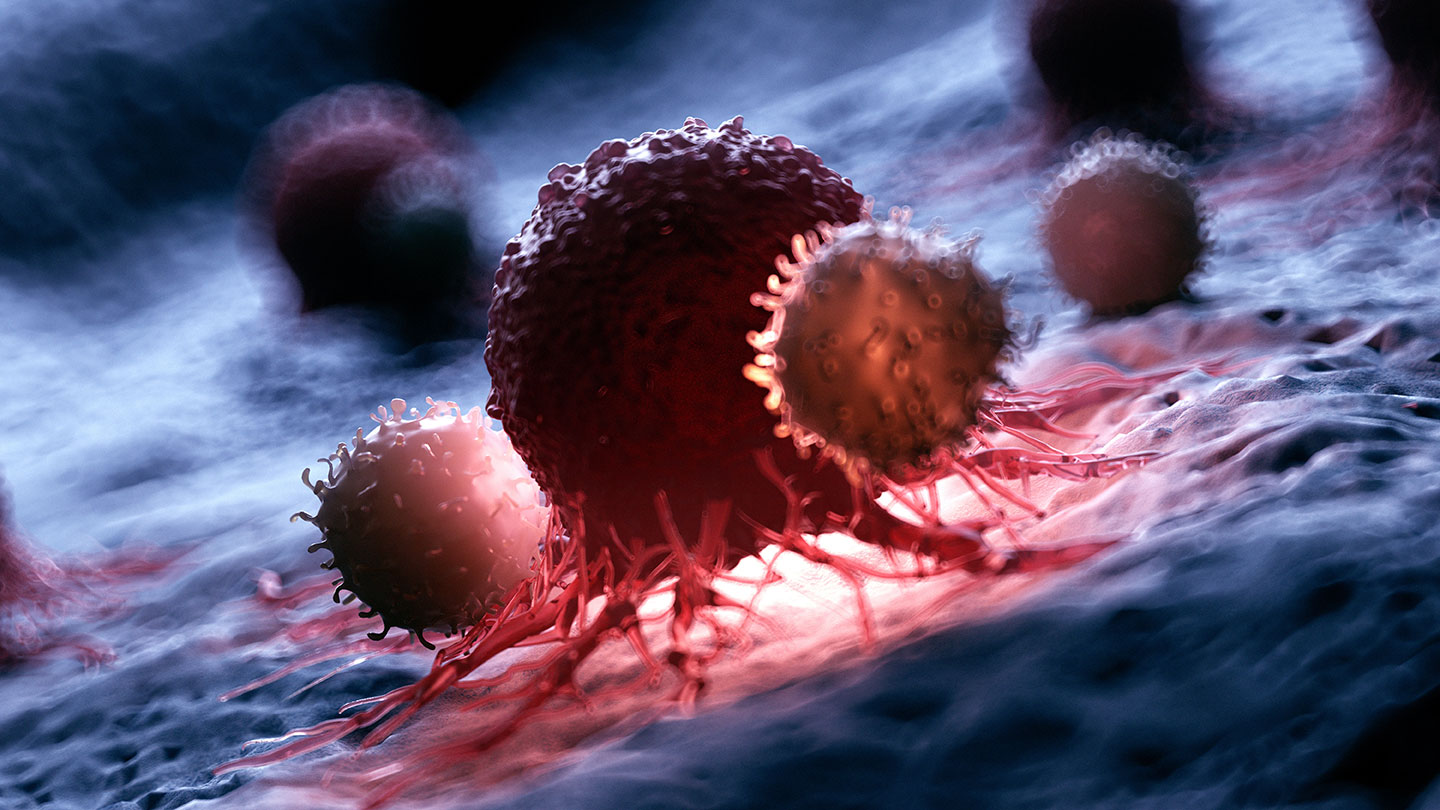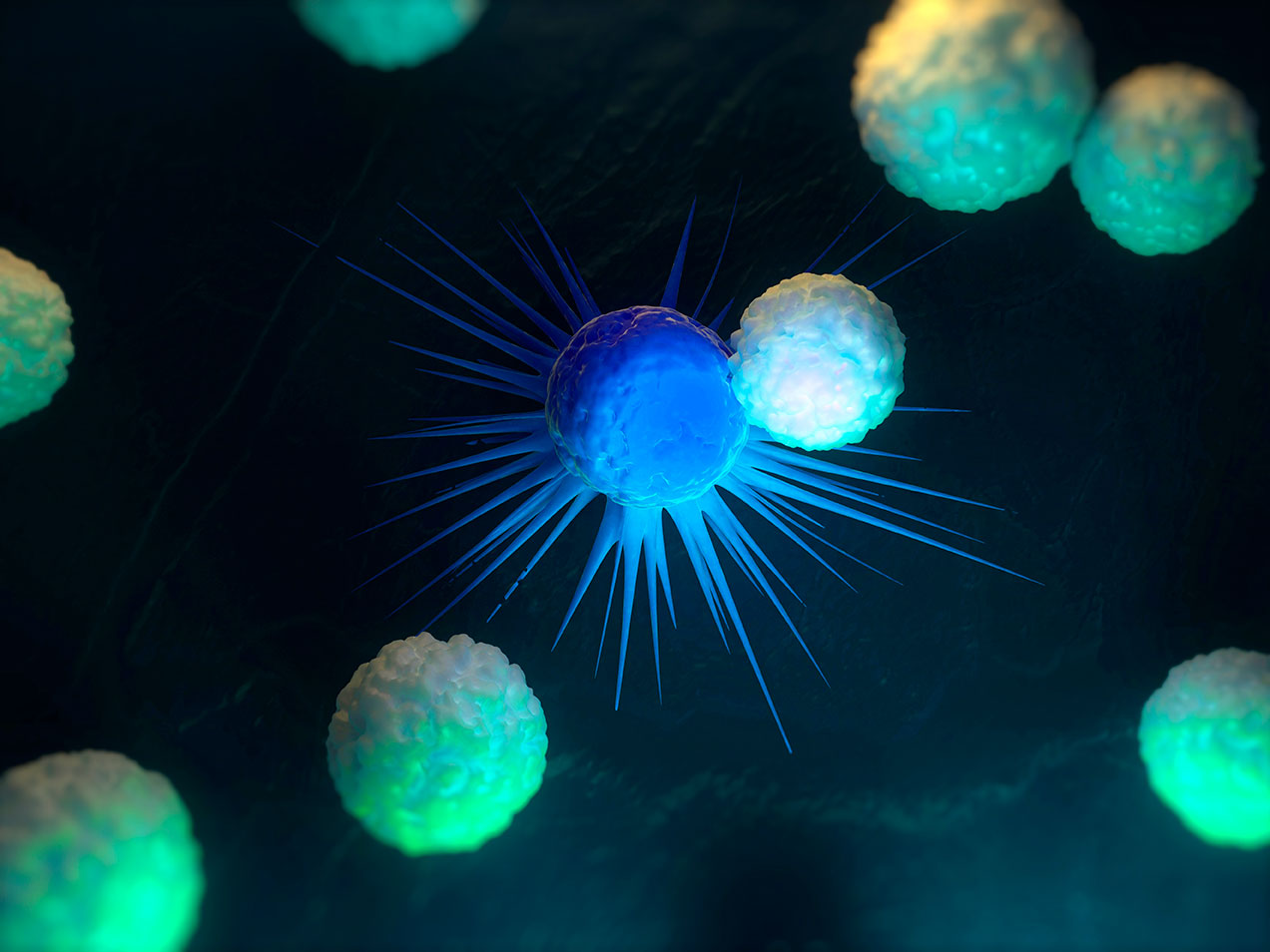Immuuntherapie: De volgende generatie kankerbehandeling
Meer dan 30 jaar geleden ontdekten onderzoekers dat ons lichaamseigen immuunsysteem in staat is om sommige soorten kanker onder bepaalde omstandigheden zelf te genezen. Deze mogelijkheid wordt doelgericht ingezet bij het ontwikkelen van nieuwe soorten immuuntherapieën. Het sterkste wapen zijn bepaalde afweercellen van het immuunsysteem, de zogenaamde T-cellen.
T-cellen bestrijden indringers, zoals bacteriën en virussen in het lichaam. Op deze manier helpen ze ziekten te voorkomen en te genezen. Bovendien kunnen T-cellen onder bepaalde omstandigheden (kanker)cellen die van nature in het lichaam worden geproduceerd, herkennen en vernietigen.
Kwaadaardige kankercellen ontwikkelen vaak mechanismen waarmee ze een immuunreactie kunnen onderdrukken of onopgemerkt blijven door het immuunsysteem.
Ons immuunsysteem beschermt ons niet alleen tegen bacteriën en virussen, maar ook tegen gedegenereerde lichaamscellen zoals bijvoorbeeld kankercellen. Elke dag verwijdert ons immuunsysteem deze cellen om de ontwikkeling van kanker te voorkomen. Maar kankercellen ontwikkelen vaak mechanismen waarmee ze het immuunsysteem misleiden of remmen waardoor de immuuncellen de kankercellen niet kunnen vernietigen. Dit is waar de immuno-oncologie om de hoek komt kijken: met behulp van diverse methoden kunnen onze eigen afweercellen kankercellen weer herkennen en effectief vernietigen.

Een volgende generatie kankerbehandeling
Operatief tumoren verwijderen, bestraling en chemotherapie - deze behandelmethoden worden vandaag de dag nog steeds het meest gebruikt in de strijd tegen kanker. Bestraling en chemotherapie gaan echter gepaard met talrijke bijwerkingen. Beiden zijn immers niet alleen effectief tegen kwaadaardige kankercellen maar ook tegen het lichaamseigen gezonde weefsels. Bijvoorbeeld giftige en radioactieve stoffen vernietigen kankercellen gerichter als ze worden gekoppeld aan antilichamen die zich binden aan een specifieke structuur op het oppervlak van tumorcellen.1,2
Bij gerichte therapieën kijken onderzoekers naar structuren die vooral op kankercellen voorkomen. Deze ontstaan door mutaties in de genetische samenstelling (genoom) van een kankercel in ontwikkeling. Hierdoor kan enerzijds de tumor gericht worden vernietigd, terwijl anderzijds de druk op kankercellen wordt opgevoerd om zich verder aan te passen om vernietiging juist te voorkomen. Dit kan ertoe leiden dat kankercellen onopgemerkt blijven. Bij immuno-oncologie is dit niet het geval en worden kankercellen weer herkent.3
Belang en ontdekking van immuno-oncologie
Terwijl gerichte kankertherapieën rechtstreeks inwerken op de tumorcel, activeert de immunotherapie het immuunsysteem van de patiënt om kanker te bestrijden.4
Het idee van immuno-oncologie is bij toeval ontstaan. In 1867 werd in Bonn (Duitsland), toen de tumor van een vrouwelijke patiënte was gekrompen nadat zij was overgebracht naar het bed van een gangreen* patiënte, ontstond het vermoeden dat het lichaamseigen afweersysteem kanker kon aanvallen en vernietigen.5 Het contact met bacteriën van de huidinfectie leidde blijkbaar tot de activering van het immuunsysteem van de patiënte. Meer dan 140 jaar later was het onderzoek op dit gebied zo ver gevorderd dat de immuno-oncologie door het wetenschappelijke tijdschrift "Science" werd uitgeroepen tot de wetenschappelijke doorbraak van het jaar 2013.6
*Gangreen is een ernstige aandoening waarbij lichaamsweefsel afsterft en eventueel gaat rotten
Mobilisatie van het lichaamseigen immuunsysteem
Immunotherapieën kunnen specifiek gericht zijn tegen de tumor of een niet-specifiek effect hebben. Bij niet-specifieke immunotherapie wordt het immuunsysteem in het algemeen geactiveerd om effectiever op te treden tegen lichaamsvreemde stoffen, ziekteverwekkers en gedegenereerde cellen.7.
De methode van checkpointremmers behoort tot de niet-specifieke immunotherapie. Zij voorkomt dat kankercellen zich vermommen als gezond weefsel en zo aan hun vernietiging ontsnappen. Daartoe worden specifieke eiwitten op het oppervlak van T-cellen (checkpoints) geblokkeerd. Anders zouden deze eiwitten zich aan tumorcellen binden en deze als onschadelijk classificeren. Immuuncheckpoints worden echter ook gebruikt om de eigen structuren van het lichaam te herkennen. Wanneer checkpoints worden geblokkeerd, is het mogelijk dat het immuunsysteem niet langer gezonde cellen tolereert maar ze ook elimineert, wat tot auto-immuun reacties kan leiden.8
T-cellen: een doeltreffend wapen tegen kanker
In tegenstelling tot niet-specifieke immunotherapie, is de verhoogde reactie van het immuunsysteem bij gerichte immunotherapie specifiek gericht tegen kankercellen. Daarbij ligt de nadruk op één groep afweercellen: T-cellen.7
T-cellen hebben een sterk celdodend effect en kunnen kankercellen op natuurlijke wijze vernietigen. Tumorcellen kunnen echter aan herkenning door T-cellen ontsnappen door zich aan te passen. Therapeutische behandelvormen in de immuno-oncologie zijn er daarom op gericht T-cellen in staat te stellen kankercellen te identificeren en ze als een gevaar te zien.

Eén methode is de Chimeric Antigen Receptor Therapie (CAR-T celtherapie), waarbij de T-cellen van de patiënt ‘tumorspecifiek’ worden gemaakt. Buiten het lichaam worden zij genetisch gemodificeerd om kankercellen efficiënter te herkennen en te vernietigen. Vervolgens worden ze teruggegeven aan de patiënt, wat adaptieve T-celtransfer wordt genoemd.9 CAR-T-cellen blijven lange tijd actief in het lichaam en moeten daarom selectief werken tegen kankercellen zonder gezond weefsel te vernietigen. De behandeling maakt deel uit van ‘personalised medicine’ en is uniek voor elke patiënt.10
Een andere innovatieve benadering is de BiTE®-technologie. Bij deze therapie binden de biotechnologisch geproduceerde bispecifieke moleculen zich tegelijkertijd aan een kankercel en aan een T-cel. Door zich tegelijkertijd aan beide celtypen te binden, zijn T-cellen in staat om eerder niet herkende kankercellen te herkennen en te vernietigen. Ze vormt als het ware een brug tussen de T-cel en de kankercel.10, 11
Virussen kunnen tumorcellen vernietigen
Tegenwoordig maken onderzoekers niet alleen gebruik van de eigenschappen van het immuunsysteem, maar ook van die van virussen in de strijd tegen kanker. Dit is mogelijk omdat het in de aard van virussen ligt om cellen aan te vallen en zich daarin te vermenigvuldigen. In het laboratorium kunnen virussen genetisch worden veranderd, zodat zij alleen kankercellen infecteren en geen gezonde cellen. Deze oncolytische virussen kunnen ook de biologische processen van kankercellen manipuleren en de productie van bepaalde signaalmoleculen en tumorspecifieke structuren van antigenen stimuleren.12,13
Na besmetting vermenigvuldigen de oncolytische virussen zich binnenin de tumorcellen tot ze uiteindelijk barsten. De virussen komen vrij en zijn in staat om nieuwe kankercellen te infecteren. Bovendien worden immuuncellen aangetrokken door signaalmoleculen. Zij kunnen de tumorspecifieke antigenen herkennen en kankercellen elders in het lichaam aanvallen die hetzelfde antigeen dragen.13
Combinatie van verschillende behandelingsmogelijkheden
De immuno-oncologie behandelingen worden steeds belangrijker. Met de toenemende diversiteit nemen ook de mogelijkheden toe om verschillende behandelingen in de immuno-oncologie te combineren. Deze combinaties worden voortdurend onderzocht om nieuwe behandelmogelijkheden te kunnen bieden aan mensen met kanker.
References
- Akbari, Bahman, et al. "Immunotoxins in cancer therapy: Review and update." International reviews of immunology 36.4 (2017): 207-219.
- Scott, Andrew M., Jedd D. Wolchok, and Lloyd J. Old. "Antibody therapy of cancer." Nature reviews cancer 12.4 (2012): 278-287.
- Shekarian, Tala, et al. "Paradigm shift in oncology: targeting the immune system rather than cancer cells." Mutagenesis 30.2 (2015): 205-211.
- Hughes, Paul E., Sean Caenepeel, and Lawren C. Wu. "Targeted therapy and checkpoint immunotherapy combinations for the treatment of cancer." Trends in immunology 37.7 (2016): 462-476.
- Busch, W. "Aus der Sitzung der medicinischen Section vom 13 November 1867." Berl Klin Wochenschr 5 (1868): 137.
- Couzin-Frankel, J. “Cancer Immunotherapy” Science (2013)
- Monjazeb, Arta M., et al. "The role of antigen-specific and non-specific immunotherapy in the treatment of cancer." Journal of immunotoxicology 9.3 (2012): 248-258.
- Thallinger, Christiane, et al. "Review of cancer treatment with immune checkpoint inhibitors." Wiener Klinische Wochenschrift 130.3-4 (2018): 85-91.
- Wang, Xiaoping, et al. "Humanized anti-EGFR antibody panitumumab inhibits tumor growth of inflammatory breast cancer by inducing antitumor immunity." (2019): 4492-4492.
- Choi, Bryan D., et al. "Bispecific antibodies engage T cells for antitumor immunotherapy." Expert opinion on biological therapy 11.7 (2011): 843-853.
- Gregory, Richard C., et al. "The anti-TGFβ neutralizing antibody, SAR439459, blocks the immunosuppressive effects of TGFβ and inhibits the growth of syngeneic tumors in combination with anti-PD1." (2018): 2790-2790.
- Gujar, Shashi A., and Patrick WK Lee. "Oncolytic virus-mediated reversal of impaired tumor antigen presentation." Frontiers in oncology 4 (2014): 77.
- Lawler, Sean E., et al. "Oncolytic viruses in cancer treatment: a review." JAMA oncology 3.6 (2017): 841-849.
